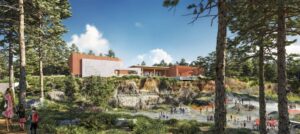
Slated to open in May, the Jean and Ric Edelman Fossil Park and Museum is 44,000 square feet of exhibit space perched above a former marl quarry, one filled with marine and terrestrial fossils from 66 million years ago, just before a massive meteorite destroyed dinosaur life on earth. This is the only facility east of the Mississippi river that features an actively open quarry for public digs.
Part of Rowan University in South Jersey, the museum and surrounding 65-acre Edelman Fossil Park will help shed light on the Late Cretaceous period—when dinosaurs roamed the New Jersey coastline—and the world’s fifth mass extinction. But while exhibitions take a look at the deep past, the structure itself is extremely forward-thinking. It blends sustainable design and eco-friendly features that include geothermal heating and cooling systems, and it aims to become New Jersey’s largest public net-zero facility, meaning it will remove as many greenhouse gasses as it emits.
Once inside, you can roam the “Hall of Cretaceous Seas,” which features dozens of marine recreations (including that of a mosasaur, a type of sea-dwelling lizard that was unearthed onsite) by world-renowned paleo sculptor Gary Staab, or visit “Critter Cove,” where you can get up-close with real-life sea and land animals, like lizards, fish and amphibians, that are genetically connected to the Late Cretaceous. There will be hands-on learning stations; a “Hall of Extinction and Hope,” where visitors can explore ways to take action against climate change; and even a paleo-themed playground for kids.
Afterwards, visitors can head outside to the quarry to dig for fossils of their own, alongside Rowan University’s top paleontologists. Fossils of boney fish and marine crocodiles have been found here, but amateur fossil hunters usually walk away with calcified shells and an occasional shark tooth.
Written by Laura Kiniry for Smithsonian Magazine
